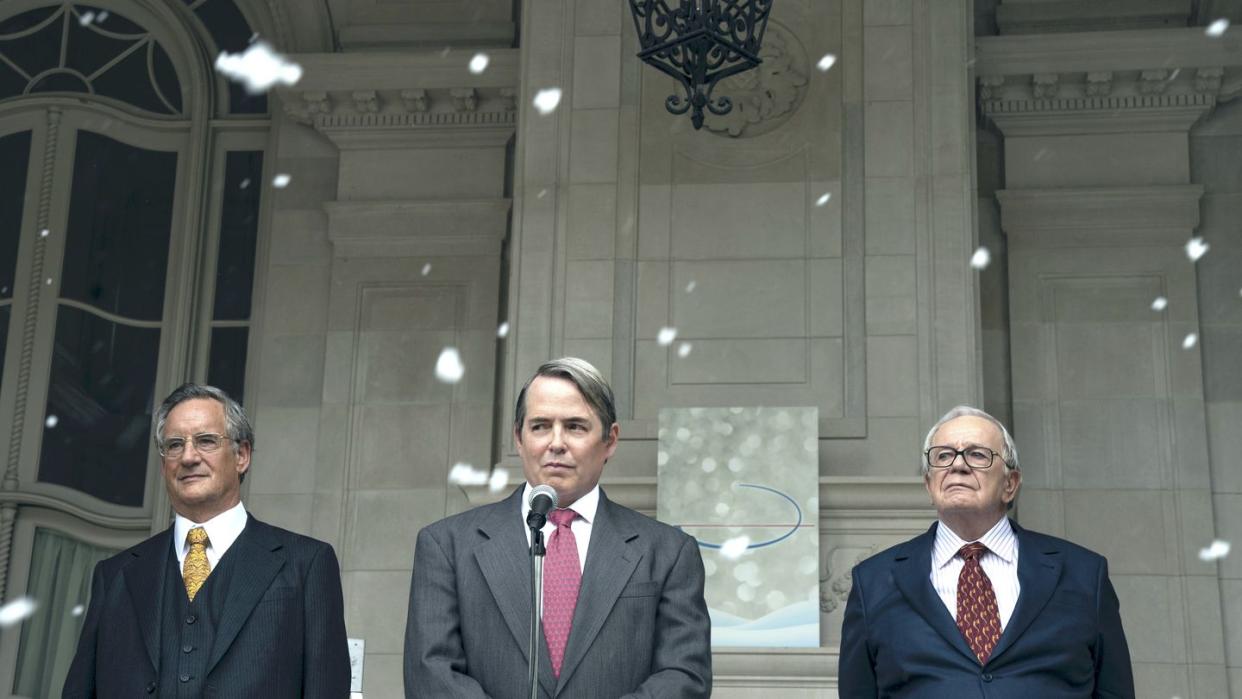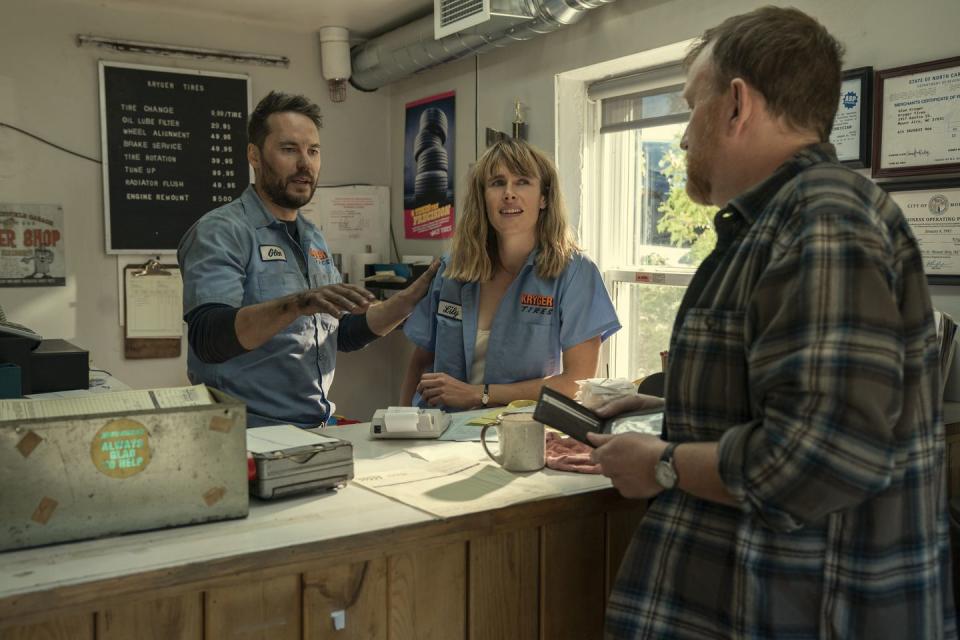The Heartbreaking True Story of Netflix’s ‘Painkiller’

- Oops!Something went wrong.Please try again later.
Netflix’s latest limited series takes on a topic so mammoth it can seem unwieldy: the opioid crisis that has ravaged the United States, contributing to a catastrophic rise in overdose deaths (more than a million Americans have died of overdoses since 2000, most of them due to opioids).
But Painkiller (now streaming), which in its quick-cutting, breezy unpacking of dense material recalls The Big Short, is also disarmingly entertaining, and even funny. The six-episode fictionalized retelling of actual events, based on The New Yorker’s “The Family That Built an Empire of Pain” by Patrick Radden Keefe and Barry Meier’s book Pain Killer, smartly focuses on one crucial corner of this tragedy: Purdue Pharma, the original maker of OxyContin, which pushed the drug into doctors’ (and thus patients’) hands, and the Sackler family that owns the company—and has earned billions off of a health disaster.
Matthew Broderick plays the real Richard Sackler, who helped spearhead the blockbuster success of OxyContin, as something of an awkward, bumbling presence—not so much immoral as amoral, unwilling to let conscience interfere with profit. Other stars playing entirely fictional characters include Uzo Aduba as a prosecutor targeting Purdue, Taylor Kitsch as a car repair shop owner who becomes addicted to OxyContin following an injury, and Dina Shihabi and West Duchovny as a couple glamorous, hot, and highly effective female sales reps for Purdue.
But where does reality end, and the fiction begin? Here are the salient facts condensed from Painkiller’s sources and other articles, to understand the alarming true story at the heart of Netflix’s show.
Who are the real people involved in the Painkiller story?

Painkiller ultimately centers on Richard Sackler (Matthew Broderick), an heir to the Sackler family’s medical and pharmaceutical dynasty. Specifically, he’s the son of Raymond, brother to Arthur and Mortimer Sackler. The elder brothers were born in Brooklyn and all became doctors.
Arthur, regarded as the patriarch of the Sacklers, became interested in pharmaceutical alternatives to midcentury psychoanalysis and electroshock therapy. He also proved adept at pharmaceutical marketing, which would go on to become a hallmark of Purdue Pharma (and as psychiatrist Allen Frances told the New Yorker, a modern “scourge” on the industry). Arthur became rich thanks to his advertising of the sedatives Librium and Valium. Through a patent-medicine company that would become Purdue Pharma, the Sacklers also created laxatives and ear wax remover.
The Sacklers were also devoted patrons of the arts and generous philanthropists (a space in New York City’s Metropolitan Museum of Art was called the Sackler Wing, until the Met removed the name in 2021 due to growing outrage over the Sacklers’ role in the opioid crisis). Richard and other younger Sacklers have carried on the philanthropic tradition, to the point that they were largely known in the media for their donations, rather than their pharmaceutical interests, until recent years. Before Arthur died in 1987, he imparted to his kids this lesson: “Leave the world a better place than when you entered it.” (Which is more than a bit ironic, given Purdue’s eventual legacy.)
After Arthur’s death, his brothers and descendants divvied up his estate. By the 1990s, Richard, as a Purdue executive, began developing a successor to the company’s MS Contin (controlled-release morphine), whose patent was expiring. Pairing oxycodone with the same controlled-release formula, the drug was released in 1996: it was called OxyContin.
Other than Broderick’s Sackler and other Sacklers (often seen amusingly bickering in the way only the wildly privileged can), Painkiller largely concocts fictional characters who seem to have been inspired by actual people (or multiple people). Uzo Aduba’s lawyer for the U.S. Attorney’s Office, Edie Flowers, could reflect any number of prosecutors who have gone after Purdue (the company has been sued thousands of times over OxyContin, including by 48 states). Likewise Taylor Kitsch’s Glen Kryger, whose life is crushed when he’s prescribed OxyContin, serves as a composite of millions of victims who have become addicted to or abused opioids. And Dina Shihabi’s Britt Hufford and West Duchovny’s Shannon Schaeffer are fictional versions of Purdue’s infamously powerful, bottom line-oriented sales team.
So what did the Sacklers do exactly, and why should I care?

Well, first, the Sacklers are rich. Very, very rich. Like, they-could-be-on-Succession rich. The family’s collective net worth is estimated at around $13 billion, according to the New York Times. And while, yes, they were born into wealth built by the elder Sackler brothers, “the bulk of the Sacklers’ fortune has been accumulated only in recent decades, yet the source of their wealth is to most people as obscure as that of the robber barons,” as the New Yorker puts it.
Sacklers have given regular interviews about their philanthropic endeavors, but have rarely spoken publicly about their business, Purdue Pharma, which is privately held and located in Stamford, Connecticut. (Richard Sackler has never given an on-the-record interview about OxyContin.) And how important has OxyContin been to Purdue’s, and the Sacklers’, accumulation of massive wealth? Well, per the New Yorker, the opioid medication “has reportedly generated some $35 billion in revenue.”
How exactly did Pharma and OxyContin contribute to the opioid crisis?

To make the long, thorny, complicated history of the current opioid crisis somewhat shorter: Before OxyContin, doctors had been generally reluctant to prescribe strong opioids because of abuse potential. Synthetic opioids are derived from the opium poppy plant, and opium has been known for its addictive properties for thousands of years.
But from the initial OxyContin rollout, Purdue strategically marketed and sold the drug in such a way that countered the prevailing hesitation about opioids. A 2002 budget plan for the company established that a primary objective was to “broaden” OxyContin’s application beyond the usual opioid uses. Thousands of sales reps reportedly received training on “overcoming objections” from doctors to which they sold. One sales line went: “The delivery system is believed to reduce the abuse liability of the drug.” A sales manager told a Florida state investigator that Purdue execs “told us to say things like it is ‘virtually’ non-addicting,” without any solid evidence.
In those early years, given the absence of a wide stigma against OxyContin, prescriptions soared, leading to “pill mills” that essentially exist to serve opioid-addicted customers. By 2003, the Drug Enforcement Administration had found that Purdue’s “aggressive methods” had “very much exacerbated OxyContin’s widespread abuse.” Yet Purdue outwardly shifted blame toward nefarious drug abusers, as in a PSA that showed a kid emptying his parents’ medicine cabinet, insisting the fault was not with the drug itself. Despite the bullish marketing, Purdue was aware of OxyContin’s rampant abuse since at least 2000, from both press reports and its own internal data, the New Yorker explains.
The end result: As doctors, particularly in the 2010s, shied away from OxyContin and other opioid prescriptions because of the stacking evidence showing how they’re abused, those who found themselves hooked often resorted to the black market. Many former legal patients ended up buying heroin, and, increasingly, fentanyl, which is roughly 50 times stronger than heroin and 100 times stronger than morphine. These street alternatives have helped lead to drastically higher overdose deaths. The New Yorker notes that recent Centers for Disease Control and Prevention figures indicate that 145 Americans die from opioid overdoses every day.
How does Netflix's Painkiller do portraying this epidemic?

Given the sweeping amount of information here, Painkiller actually does quite well in turning out a seamless, somewhat pulpy narrative! The series comes from executive producers Eric Newman (Narcos), Peter Berg (Friday Night Lights, Lone Survivor), and Alex Gibney (Going Clear). Berg, directing all six episodes, is the opposite of subtle: Characters often speak in barely disguised exposition, and there are annoying exaggerated tendencies (especially one doctor’s arbitrary, fake German accent). But it all moves along nimbly.
And it’s hard to knock the acting. Matthew Broderick is marvelous as a Ferris Bueller type—if Bueller grew up to fumble his way into a dangerous pharmaceutical empire (watching him aimlessly wander his mansion provides some rueful laughs). Uzo Aduba pulls off the tireless, no-nonsense prosecutor role, making Edie Flowers almost comically tense. Taylor Kitsch credibly reprises his stoic, wounded Taylor Kitsch schtick. But Dina Shihabi and West Duchovny nearly run away with the show, mesmerizing as women of different generations who hide deep insecurities with bulletproof smiles, cleavage, and talking points. Watching these plucky blondes actualize their material dreams as they nevertheless assist in a scheme that ruins lives is bittersweet, mostly bitter—a strivers’ story gone wrong as only America can tell it.
You Might Also Like

